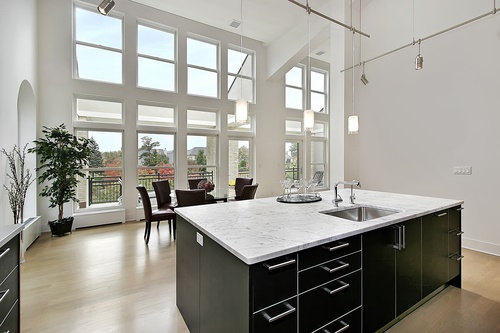Lots of window products are labeled as energy efficient, but there is a wide variety of performance among these options. The use of standardized ratings can help you compare your options. There are various kinds of glass and construction used to make energy efficient windows, and the numbers tell you the bottom line:
- Low U-factor means the window does not transmit much heat in either direction. The lower the U-factor, the better the window will contain cooled or heated air indoors (and block outdoor temperatures from coming inside).
- Low SHGC, the solar heat gain coefficient, tells you that the window blocks solar rays from heating the home. In a warmer climate, energy efficient windows have a low SHGC to prevent overheating in the summer. For rooms that do not get hot during summer and instead need sunlight to warm up in the winter, a higher SHGC is preferred.
- Low-E glass and coatings improve the SHGC by reflecting UV rays away from the home. Low-E is highly recommended to help with cooling.
- Air leakage refers to drafts around the glass or frame. Vinyl frames make excellent energy efficient windows because the frame prevents leaks better than wood — provided installation is done correctly.

Choosing Windows Based on Direction of Sunlight
For year-round comfort and energy savings, you may need different kinds of glass in different locations of the home.
Windows that face north — and do not get overheated in the summer — should have a higher SHGC to let in warmth during the coldest months. The U-factor and other indicators of energy efficient windows are still very important, though.
Rooms with south, east and west windows face more direct sunlight in the morning and afternoon. Low U-factor and SHGC are both critical. Quality low-e coatings also help by letting in natural sunlight while blocking harmful UV rays and heat.
The Importance of Window Installation Quality
Remember, the advertised ratings and statistics for energy efficient windows can only be achieved if everything gets installed properly. Air leaks and other flaws can let your conditioned air pour out and let ambient air enter the home — undoing the benefits of the great technology in the glass and frame.
Window installation should always be performed by a professional. More specifically, a glass expert should handle the job rather than a handyman.
Style Options for Energy Efficient Windows
From traditional and historic homes to modern architecture, there are energy efficient windows available for whatever style you need. You can take the opportunity to makeover the exterior look of the home, or find a very close match to your existing windows.
Energy efficiency can be achieved through Vinyl and wood-clad frames. Vinyl frames in particular are readily available in more styles and color options than ever before.
You can also choose the window’s opening method. Sash windows are very popular, but the most energy efficient windows are often hinged casement or awning windows. Hinged windows shut more tightly and can be cracked for ventilation in mild weather. Contact us for more information on theses energy saving processes.
